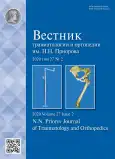Early complications of reverse total shoulder arthroplasty
- Authors: Lychagin A.V.1, Kesian G.A.2, Kalinskу E.B.1, Sukharev N.A.1
-
Affiliations:
- I.M. Sechenov First Moscow State Medical University (Sechenov University)
- National Medical Research Center for Traumatology and Orthopedics named after N.N. Priorov
- Issue: Vol 27, No 2 (2020)
- Pages: 10-14
- Section: Original study articles
- URL: https://bakhtiniada.ru/0869-8678/article/view/34838
- DOI: https://doi.org/10.17816/vto202027210-14
- ID: 34838
Cite item
Full Text
Abstract
Background. The frequency of early complications after reverse shoulder arthroplasty remains high enough, and the overall complication rate is reported from 4.7% to 38%.
Methods. We did 23 primary reverse shoulder arthroplasty and used clinical information after these operations in our study. As a comparative material, we used date from registers of foreign countries, as well as information from special literature.
Results. Early complications were found in five cases (21.7%) in our study: two cases (8.7%) of a periprosthetic fracture; three patients (13.2%) had dislocation components. We studied these complications and formulated rules preventive measures.
Conclusions. (1) The most common early complications after revers total shoulder arthroplasty were instability components, periprosthetic fracture. (2) These types of complications arise due to unbalanced soft tissues, inadequate selection of the size of the glenosphere, interposition of soft tissues, and inadequate term of loads on the operated limb. (3) The number of these complications can be reduced by observing preventive measures at all stages of treatment.
Full Text
##article.viewOnOriginalSite##About the authors
Aleksey V. Lychagin
I.M. Sechenov First Moscow State Medical University (Sechenov University)
Email: baizil@inbox.ru
PhD, Professor
Russian Federation, MoscowGuren A. Kesian
National Medical Research Center for Traumatology and Orthopedics named after N.N. Priorov
Email: baizil@inbox.ru
PhD, Head of Department
Russian Federation, MoscowEugeny B. Kalinskу
I.M. Sechenov First Moscow State Medical University (Sechenov University)
Email: baizil@inbox.ru
MD, Associate Professor
Russian Federation, MoscowNikilay A. Sukharev
I.M. Sechenov First Moscow State Medical University (Sechenov University)
Author for correspondence.
Email: baizil@inbox.ru
Post-graduate student
Russian Federation, MoscowReferences
- Зарайский А.С., Зоря В.И. Эндопротезирование плечевого сустава. Проблемы и решения. Московский хирургический журнал. 2011;(4):58-64. [Zarayskiy AS, Zoray VI. Shoulder arthroplasty. Problems and decision. Moskovskii khirurgicheskii zhurnal. 2011;(4):58-64. (In Russ.)]
- Australian Orthopaedic Association National Joint Replacement Registry [Internet]. Annual Report 2019 [cited 2017 Apr 20]. Available at: https://aoanjrr.sahmri.com/annual-reports-2019
- National Joint Registry [Internet]. 13th Annual Report 2016: National Joint Registry for England, Wales, Northern Ireland and the Isle of Man. NJR Centre, Hemel Hempstead, United Kingdom [cited 2017 Apr 20]. Available at: https://www.hqip.org.uk/wp-content/uploads/2018/02/national-joint-registry-13th-annual-report-2016.pdf
- Regional Register of Orthopaedic Prosthetic Implantology [Internet]. REPORT of R.I.P.O. Hip, Knee and Shoulder Arthroplasty. RIPO, Emilia-Romagna, Italy [cited 2017 Apr 20]. Available at: https://ripo.cineca.it/RIPO_REPORT_2015_english_rev1.pdf
- New Zealand Orthopaedic Association (NZOA) [Internet]. The New Zealand Joint Registry. Seventeen Year Report.NZOA, Wellington, New Zealand [cited 2017 Apr 20]. Available at: https://nzoa.org.nz/system/files/NZJR%2017%20year%20Report.pdf
- Sanchez-Sotelo J. Reverse total shoulder arthroplasty. Clin Anat. 2008;22(2):172-182. https://doi.org/10.1002/ca.20736.
- Farshad M, Gerber C. Reverse total shoulder arthroplasty — from the most to the least common complication. Int Orthop. 2010;34(8):1075-1082. https://doi.org/10.1007/s00264-010-1125-2.
- Zumstein MA, Pinedo M, Old J, Boileau P. Problems, complications, reoperations, and revisions in reverse total shoulder arthroplasty: a systematic review. J Shoulder Elbow Surg. 2011;20(1):146-157. https://doi.org/10.1016/j.jse.2010.08.001.
- Cheung E, Willis M, Walker M, Clark R, Frankle MA. Complications in reverse shoulder arthroplasty. J Am Acad Orthop Surg. 2011;19(7):439-449.
- Choi S, Bae J, Kwon YS, Kang H. Clinical outcomes and complications of cementless reverse total shoulder arthroplasty during the early learning curve period. J Orthop Surg Res. 2019;14(1):53. https://doi.org/10.1186/s13018-019-1077-1.
- Barco R, Savvidou OD, Sperling JW, Sanchez-Sotelo J, Cofield RH. Complications in reverse shoulder arthroplasty. EFORT Open Rev. 2016;1(3):72-80. https://doi.org/10.1302/2058-5241.1.160003
- Giuseffi SA, Streubel P, Sperling J, Sanchez-Sotelo J. Short-stem uncemented primary reverse shoulder arthroplasty: clinical and radiological outcomes. Bone Joint J. 2014;96-B(4):526-529. http://dx.doi.org/10.1302/0301-620X.96B3.32702.
- García-Fernández C, Lópiz-Morales Y, Rodríguez A, López-Durán L, Martínez FM. Periprosthetic humeral fractures associated with reverse total shoulder arthroplasty: incidence and management. Int Orthop. 2015;39(10):1965-1969. https://doi.org/10.1007/s00264-015-2972-7.
- Boileau P. Complications and revision of reverse total shoulder arthroplasty. Orthop Traumatol Surg Res. 2016;102(1 Suppl):S33–S43. https://doi.org/10.1016/j.otsr.2015.06.031.
- Lawrence C, Williams GR, Namdari S. Influence of glenosphere design on outcomes and complications of reverse arthroplasty: a systematic review. Clin Orthop Surg. 2016;8(3):288-297. https://doi.org/10.4055/cios.2016.8.3.288.
- Ненашев Д.В., Майков С.В. Применение алгоритма выбора хирургической тактики при эндопротезировании плечевого сустава. Профилактическая и клиническая медицина. 2011;(3):413–415. [Nenashev DV, Maykov SV. Algorithm selection surgical tiontactics in shoulder joint arthroplasty. Profilakticheskaya i klinicheskaya meditsina. 2011;(3):413-415. (In Russ.)]
- Gutiérrez S, Comiskey CA, IV, Luo ZP, Pupello DR, Frankle MA. Range of impingement-free abduction and adduction deficit after reverse shoulder arthroplasty. Hierarchy of surgical and implant-design-related factors. J Bone Joint Surg Am. 2008;90(12):2606-2615. https://doi.org/10.2106/JBJS.H.00012.
- Roche C, Flurin PH, Wright T, Crosby LA, Mauldin M, Zuckerman JD. An evaluation of the relationships between reverse shoulder design parameters and range of motion, impingement, and stability. J Shoulder Elbow Surg. 2009;18(5):734-741. https://doi.org/10.1016/j.jse.2008.12.008.
- Wierks C, Skolasky RL, Ji JH, McFarland EG. Reverse total shoulder replacement: intraoperative and early postoperative complications. Clin Orthop Relat Res. 2009;467(1):225-234. https://doi.org/10.1007/s11999-008-0406-1.
- Lädermann A, Lübbeke A, Mélis B, Stern R, Christofilopoulos P, Bacle G, Walch G. Prevalence of neurologic lesions after total shoulder arthroplasty. J Bone Joint Surg Am. 2011;93(14):1288-1293. https://doi.org/10.2106/JBJS.J.00369.
Supplementary files











